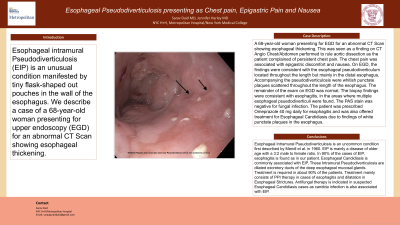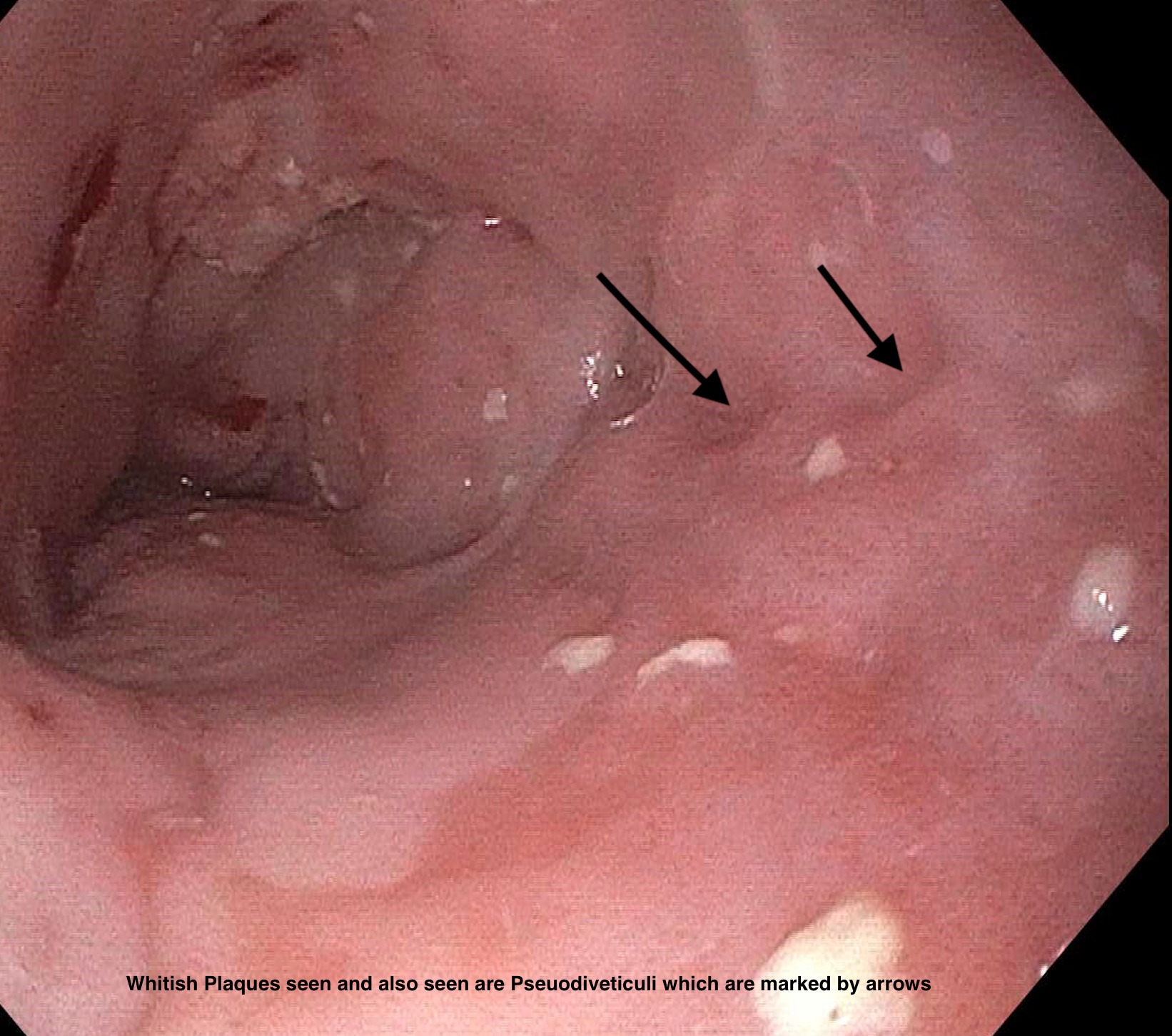Back

Poster Session A - Sunday Afternoon
Category: Esophagus
A0233 - Esophageal Pseudodiverticulosis Presenting as Chest Pain, Epigastric Pain and Nausea
Sunday, October 23, 2022
5:00 PM – 7:00 PM ET
Location: Crown Ballroom

- SD
Sarav Daid, MD
New York Medical College/ Metropolitan Medical Center
New York, NY
Presenting Author(s)
Sarav Daid, MD1, Jennifer Harley, MD2
1New York Medical College/ Metropolitan Medical Center, New York, NY; 2New York Medical College/ NYCHH – Metropolitan Hospital Center, Manhattan, NY
Introduction: Esophageal intramural Pseudodiverticulosis (EIP) is an unusual condition manifested by tiny flask-shaped out pouches in the wall of the esophagus. We describe a case of a 68-year-old woman presenting for upper endoscopy (EGD) for an abnormal CT Scan showing esophageal thickening.
Case Description/Methods: A 68-year-old woman presenting for EGD for an abnormal CT Scan showing esophageal thickening. This was seen as a finding on CT Angio Chest/Abdomen performed to rule aortic dissection as the patient complained of persistent chest pain. The chest pain was associated with epigastric discomfort and nausea. On EGD, the findings were consistent with the esophageal pseudodiverticulum located throughout the length but mainly in the distal esophagus. Accompanying the pseudodiverticulosis were whitish punctate plaques scattered throughout the length of the esophagus. The remainder of the exam on EGD was normal. The biopsy findings were consistent with esophagitis, in the areas where multiple esophageal psuedodiverticuli were found. The PAS stain was negative for fungal infection. The patient was prescribed Omeprazole 40 mg daily for esophagitis and was also offered treatment for Esophageal Candidiasis due to findings of white punctate plaques in the esophagus.
Discussion: Esophageal Intramural Pseudodiverticulosis is an uncommon condition first described by Mendl et al. in 1960. EIP is mainly a disease of older age with a 3:2 male to female ratio. In 90% of the cases of EIP, esophagitis is found as in our patient. Esophageal Candidiasis is commonly associated with EIP. These Intramural Pseudodiverticulosis are dilated excretory ducts of the deep esophageal mucosal glands. Treatment is required in about 90% of the patients. Treatment mainly consists of PPI therapy in cases of esophagitis and dilatation in Esophageal Strictures. Antifungal therapy is indicated in suspected Esophageal Candidiasis cases as candida infection is also associated with EIP.

Disclosures:
Sarav Daid, MD1, Jennifer Harley, MD2. A0233 - Esophageal Pseudodiverticulosis Presenting as Chest Pain, Epigastric Pain and Nausea, ACG 2022 Annual Scientific Meeting Abstracts. Charlotte, NC: American College of Gastroenterology.
1New York Medical College/ Metropolitan Medical Center, New York, NY; 2New York Medical College/ NYCHH – Metropolitan Hospital Center, Manhattan, NY
Introduction: Esophageal intramural Pseudodiverticulosis (EIP) is an unusual condition manifested by tiny flask-shaped out pouches in the wall of the esophagus. We describe a case of a 68-year-old woman presenting for upper endoscopy (EGD) for an abnormal CT Scan showing esophageal thickening.
Case Description/Methods: A 68-year-old woman presenting for EGD for an abnormal CT Scan showing esophageal thickening. This was seen as a finding on CT Angio Chest/Abdomen performed to rule aortic dissection as the patient complained of persistent chest pain. The chest pain was associated with epigastric discomfort and nausea. On EGD, the findings were consistent with the esophageal pseudodiverticulum located throughout the length but mainly in the distal esophagus. Accompanying the pseudodiverticulosis were whitish punctate plaques scattered throughout the length of the esophagus. The remainder of the exam on EGD was normal. The biopsy findings were consistent with esophagitis, in the areas where multiple esophageal psuedodiverticuli were found. The PAS stain was negative for fungal infection. The patient was prescribed Omeprazole 40 mg daily for esophagitis and was also offered treatment for Esophageal Candidiasis due to findings of white punctate plaques in the esophagus.
Discussion: Esophageal Intramural Pseudodiverticulosis is an uncommon condition first described by Mendl et al. in 1960. EIP is mainly a disease of older age with a 3:2 male to female ratio. In 90% of the cases of EIP, esophagitis is found as in our patient. Esophageal Candidiasis is commonly associated with EIP. These Intramural Pseudodiverticulosis are dilated excretory ducts of the deep esophageal mucosal glands. Treatment is required in about 90% of the patients. Treatment mainly consists of PPI therapy in cases of esophagitis and dilatation in Esophageal Strictures. Antifungal therapy is indicated in suspected Esophageal Candidiasis cases as candida infection is also associated with EIP.

Figure: In this image, whitish plaques are seen. We can also see pseudodiverticula ( marked by arrows ).
Disclosures:
Sarav Daid indicated no relevant financial relationships.
Jennifer Harley indicated no relevant financial relationships.
Sarav Daid, MD1, Jennifer Harley, MD2. A0233 - Esophageal Pseudodiverticulosis Presenting as Chest Pain, Epigastric Pain and Nausea, ACG 2022 Annual Scientific Meeting Abstracts. Charlotte, NC: American College of Gastroenterology.
